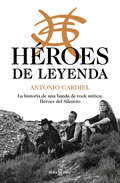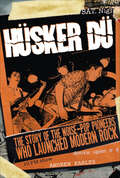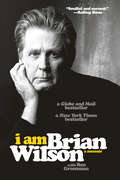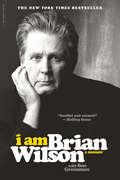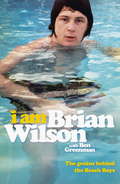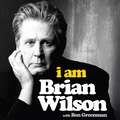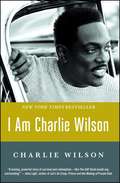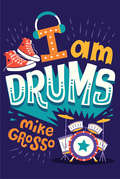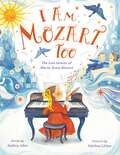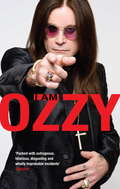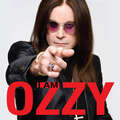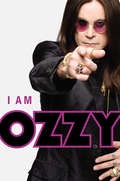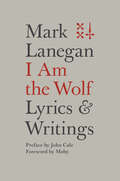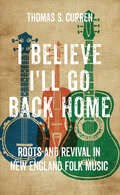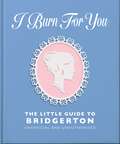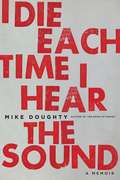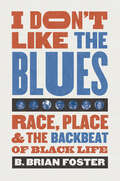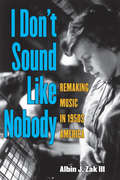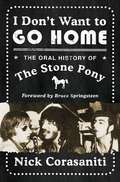- Table View
- List View
Hyper-specializing in Saxophone Using Acoustical Insight and Deep Listening Skills (Current Research in Systematic Musicology #6)
by Jonas BraaschThis book presents a novel method of grafting musical wind instruments by exchanging an instrument’s standard mouthpiece with different tone generators. Using the concrete example of the soprano saxophone, it describes how, with six other tone generators, including brass, double reed, and free reed mechanisms, the saxophone can be extended to nearly every wind instrument category in the von Hornbostel and Sachs classification system. The book demonstrates how it is possible to play these instrument variations with high proficiency, and describes the method of hyper-specialization, including acoustical insights, conservatory training methods and the underlying philosophy. The latter is based on the cultural traditions of the different wind instrument prototypes and the Deep Listening philosophy of cultivating internal diversity, and approach that leads to a new level of wind instrument virtuosity that offers great timbral variety combined with the flexibility of a regular acoustic wind instrument.
Héroes de leyenda: La historia de una banda de rock mítica: Héroes del Silencio
by Antonio CardielPor fin la historia jamás contada de uno de los grupos más míticos del pop-rock español. Avalada por los músicos y contada desde dentro por el hermano del bajista, HÉROES DE LEYENDA es la biografía más personal y completa de la mítica banda. Héroes del silencio, una de las bandas de rock más famosas e internacionales de nuestro país, que incluso tras su disolución todavía cuenta con miles y miles de fans acérrimos, tiene por fin el libro que merece. Un grupo obsesionado por la excelencia y quizás esto fue lo que les llevó a ser pioneros en terrenos intransitados entonces en España: 700 conciertos ofrecidos en 30 países entre Europa y América; compañeros de cartel de bandas como Texas, Aerosmith o Iron Maiden, y solistas como Leonard Cohen, Robert Plant o Bryan Adams; asistencia a los festivales de verano más importantes de Europa, como el Rock amRing y el Rock Insel; decenas de discos piratas que todavía se siguen editando; grabaciones de unplugged para la MTV... Antonio Cardiel ha tenido la oportunidad de entrevistar en exclusiva y detenidamente a sus componentes, relata de forma amena y rigurosa la historia del grupo: su formación, sus comienzos musicales, su escalada hacia el éxito, su época en la cima y su posterior disolución. Además, abunda en revelaciones sobre el proceso creativo de Héroes y la génesis de sus temas más importantes, sobre las giras que hicieron por Europa y América, e incluye fotografías que nunca antes habían visto la luz y muchas anécdotas desconocidas. Una vida al más puro estilo del rock and roll, en cuyo nombre libraron muchas batallas, dentro y fuera de los escenarios.
Hüsker Dü: The Story of the Noise-Pop Pioneers Who Launched Modern Rock
by Andrew EarlesBob Mould, Grant Hart, and Greg Norton formed Hüsker Dü in 1979 as a wildly cathartic outfit fueled by a cocktail of anger, volume, and velocity. Here's the first book to dissect the trio that countless critics and musicians have cited as one of the most influential bands of the 1980s. Author Andrew Earles examines how Hüsker Dü became the first hardcore band to marry pop melodies with psychedelic influences and ear-shattering volume. Readers witness the band create the untouchable noise-pop of LPs like New Day Rising, Flip Your Wig, and Candy Apple Grey, not to mention the sprawling double-length Zen Arcade. Few bands from the original American indie movement did more to inform the alternative rock styles that breached the mainstream in the 1990s. Hüsker Dü truly were visionaries.
I Ain't Studdin' Ya: My American Blues Story
by Bobby RushExperience music history with this memoir by one of the last of the genuine old school Blues and R&B legends, the Grammy-winning dynamic showman Bobby Rush. This memoir charts the extraordinary rise to fame of living blues legend, Bobby Rush. Born Emmett Ellis, Jr. in Homer, Louisiana, he adopted the stage name Bobby Rush out of respect for his father, a pastor. As a teenager, Rush acquired his first real guitar and started playing in juke joints in Little Rock, Arkansas, donning a fake mustache to trick club owners into thinking he was old enough to gain entry. He led his first band in Arkansas between Little Rock and Pine Bluff in the 1950s. It was there he first had Elmore James play in his band. Rush later relocated to Chicago to pursue his musical career and started to work with Earl Hooker, Luther Allison, and Freddie King, and sat in with many of his musical heroes, such as Howlin' Wolf, Muddy Waters, Jimmy Reed and Little Walter. Rush eventually began leading his own band in the 1960s, crafting his own distinct style of funky blues, and recording a succession of singles for various labels. It wasn't until the early 1970s that Rush finally scored a hit with "Chicken Heads." More recordings followed, including an album which went on to be listed in the Top 10 blues albums of the 1970s by Rolling Stone and a handful of regional jukebox favorites including "Sue" and "I Ain't Studdin' Ya." And Rush's career shows no signs of slowing down now. The man once beloved for performing in local jukejoints is now headlining major music/blues festivals, clubs, and theaters across the U.S. and as far as Japan and Australia. At age eighty-six, he is still on the road for over 200 days a year. His lifelong hectic tour schedule has earned him the affectionate title "King of the Chitlin' Circuit," from Rolling Stone. In 2007, he earned the distinction of being the first blues artist to play at the Great Wall of China. His renowned stage act features his famed shake dancers, who personify his funky blues and his ribald sense of humor. He was featured in Martin Scorcese's The Blues docuseries on PBS, a documentary film called Take Me to the River, performed with Dan Aykroyd on The Tonight Show Starring Jimmy Fallon, and most recently had a cameo in the Golden Globe nominated Netflix film, Dolemite Is My Name, starring Eddie Murphy. He was recently given the highest Blues Music Award honor of B.B. King Entertainer of the Year. His songs have also been featured in TV shows and films including HBO's Ballers and major motion pictures like Black Snake Moan, starring Samuel L. Jackson. Considered by many to be the greatest bluesman currently performing, this book will give readers unparalleled access into the man, the myth, the legend: Bobby Rush.
I Am Brian Wilson
by Ben Greenman Brian WilsonFor the first time in his own words, the legendary musical genius of The Beach Boys reflects on his tumultuous life and astonishing 21st-century comeback to live performance and renewed creativity.Brian Wilson was the driving creative force behind The Beach Boys, a band that defined an era and charted nine consecutive gold albums and hit after unstoppable hit. But he was derailed in the 1970s by mental illness, drug use, and the shifting fortunes of the band he'd helped to create. In the late 1980s, while still under the thumb of a disreputable therapist, he reemerged as a solo artist, though his living conditions made that unsustainable. Amazingly, he persisted. He found the right support network, including his second wife, Melinda, the right doctors and the right medication and, with their help, he found his way back to the foundation of his creativity. In the 2000s, for the first time ever, Wilson became a viable solo performance artist. And he was at last able to complete Smile, the unfinished Beach Boys record that had become both the symbol of his genius and of his destabilization. I Am Brian Wilson is the story of Brian Wilson's life, told by Brian Wilson. But he's not the same man who had a nervous breakdown on an airplane in 1964 or the one who ballooned to 300 pounds and couldn't get out of bed in the 1970s. This Brian Wilson is older, calmer, filled with perspective regarding his extraordinary accomplishments and forgiveness for the people who complicated those accomplishments, and his life. Wiser, more measured, though still possessed of the youthful spark that helped him rise to the top of the rock and roll world, Wilson relates his life with a level of emotional honesty that has eluded authors of scores of previous works on Brian and The Beach Boys: "Telling my story honestly means remembering things I sometimes prefer to forget. I would like people to get to know what I've gone through, and I hope that my story will give them strength."
I Am Brian Wilson: A Memoir
by Ben Greenman Brian WilsonThey say there are no second acts in American lives, and third acts are almost unheard of. That's part of what makes Brian Wilson's story so astonishing.As a cofounding member of the Beach Boys in the 1960s, Wilson created some of the most groundbreaking and timeless popular music ever recorded. With intricate harmonies, symphonic structures, and wide-eyed lyrics that explored life's most transcendent joys and deepest sorrows, songs like "In My Room," "God Only Knows," and "Good Vibrations" forever expanded the possibilities of pop songwriting. Derailed in the 1970s by mental illness, drug use, and the shifting fortunes of the band, Wilson came back again and again over the next few decades, surviving and-finally-thriving. Now, for the first time, he weighs in on the sources of his creative inspiration and on his struggles, the exhilarating highs and the debilitating lows.I Am Brian Wilson reveals as never before the man who fought his way back to stability and creative relevance, who became a mesmerizing live artist, who forced himself to reckon with his own complex legacy, and who finally completed Smile, the legendary unfinished Beach Boys record that had become synonymous with both his genius and its destabilization. Today Brian Wilson is older, calmer, and filled with perspective and forgiveness. Whether he's talking about his childhood, his bandmates, or his own inner demons, Wilson's story, told in his own voice and in his own way, unforgettably illuminates the man behind the music, working through the turbulence and discord to achieve, at last, a new harmony.
I Am Brian Wilson: The genius behind the Beach Boys
by Brian Wilson'My life has been written about over and over again, and that's mostly okay with me. Other people can talk about my life. Sometimes they'll get it right and sometimes they'll get it wrong. For me, when I think back across my own life, there are so many things that are painful. Sometimes I don't like discussing them. Sometimes I don't even like remembering them. But as I get older, the shape of that pain has changed. Sometimes memories come back to me when I least expect them. Maybe that's the only way it works when you've lived the life I've lived: starting a band with my brothers that was managed by my father, watching my father become difficult and then impossible, watching myself become difficult and then impossible, watching women I loved come and go, watching children come into the world, watching my brothers get older, watching them pass out of the world. Some of those things shaped me. Others scarred me. Sometimes it was hard to tell the difference. When I watched my father fly into a rage and take swings at me and my brothers, was that shaping or scarring? When we watched him grow frustrated with his day job and take solace in music, was that shaping or scarring? Those are all memories but I can't get to them all at once. I've had a whole lifetime to take them in. Now I have a whole book to put them out there.'Excerpt from I Am Brian Wilson
I Am Brian Wilson: The genius behind the Beach Boys
by Brian WilsonThey say there are no second acts in American lives, and third acts are almost unheard of. That's part of what makes Brian Wilson's story so astonishing. As co-founder member of the Beach Boys in the 1960s, Wilson created some of the most groundbreaking and timeless popular music ever recorded. With intricate harmonies, symphonic structures, and wide-eyed lyrics that explored life's most transcendent joys and deepest sorrows, songs like 'In My Room', 'God Only Knows' and 'Good Vibrations' forever expanded the possibilities of pop songwriting. Derailed in the 1970s by mental illness, drug use, and the shifting fortunes of the band, Wilson came back again and again over the next few decades, surviving and - finally - thriving. Now, for the first time, he weighs in on the sources of his creative inspiration and on his struggles, the exhilarating highs and the debilitating lows. I Am Brian Wilson reveals as never before the man who fought his way back to stability and creative relevance, who became a mesmerizing live artist, who forced himself to reckon with his own complex legacy and completed Smile, the legendary unfinished Beach Boys record that had become synonymous with both his genius and its destabilization. Today Brian Wilson is older, calmer, filled with perspective and forgiveness. Whether he's talking about his childhood, his bandmates, or his own inner demons, Wilson's story, told in his own voice and in his own way, unforgettably illuminates the man behind the music, working through the turbulence and discord to achieve, at last, a new harmony.(P) 2016 Audible, Inc.
I Am Charlie Wilson
by Charlie WilsonThe long-awaited New York Times bestselling memoir of seven-time Grammy-nominated artist Charlie Wilson, the iconic R&B and Funk singer-songwriter-producer and former lead singer of The Gap Band—interwoven with his recollections of collaborating with fellow artists such as Stevie Wonder, Kanye West, and Snoop Dogg.Recognized the world over for his distinct voice and timeless hits spanning a career of nearly half a century, Charlie Wilson is one of the most celebrated musicians of his generation. So it took friends and family by surprise when he checked into rehab and revealed that he had been not only homeless, but also helpless. Here is the riveting story of how love and faith carried him through not only his addiction, but also prostate cancer. Here, too, is the story of his work in the music business, including a career resurgence that saw collaborations with some of the most sought-after artists of today, including Pharrell and Justin Timberlake. Now over twenty years sober, Wilson recounts a life filled with vertiginous highs and heartbreaking lows. His is a story of triumph over adversity, courage in the face of extreme hardship, and love when all else is lost. It is a tale of the last sixty years in social and pop culture history, and one that will stay with you for years to come.
I Am Drums
by Mike Grosso"This book is the song of my middle-school heart."--Michelle Schusterman, author of the I Heart Band! series Sam knows she wants to be a drummer. But she doesn't know how to afford a drum kit, or why budget cuts end her school's music program, or why her parents argue so much, or even how to explain her dream to other people. But drums sound all the time in Sam's head, and she'd do just about anything to play them out loud--even lie to her family if she has to. Will the cost of chasing her dream be too high? An exciting new voice in contemporary middle grade, Mike Grosso creates a determined heroine readers will identify with and cheer for.
I Am Mozart, Too: The Lost Genius of Maria Anna Mozart
by Audrey AdesTo everyone who has heard of my famous younger brother but has never heard of me.I Am Mozart, Too is a picture book biography about Wolfgang's older sister, Maria Anna Mozart, who was a child prodigy and a secret composer, perfect for Women's History Month.Nannerl and Wolfie love playing the harpsichord together. They are so talented, the Mozart siblings perform all over Europe for packed audiences in beautiful concert halls. Even Empress Maria Theresa requests that they stop in Vienna to play especially for her.But then Nannerl does something naughty: She starts writing music of her own. Papa fumes. Girls are not allowed to compose! Girls belong behind the curtain.While Wolfie’s solo career takes flight, Nannerl must settle for a life offstage. But it doesn’t stop her from pursuing her dreams in secret.With vivid, sweeping art by Adelina Lirius, author Audrey Ades tells the powerful true story of a talented, ambitious girl who has been hidden from history—a girl who was and always will be a genius, too.
I Am Ozzy
by Ozzy Osbourne'Mightily entertaining' - Heat People ask me how come I'm still alive, and I don't know what to say. When I was growing up, if you'd have put me up against a wall with the other kids from my street and asked me which one of us was gonna make it to the age of sixty, with five kids and four grandkids and houses in Buckinghamshire and California, I wouldn't have put money on me, no f**king way. But here I am: ready to tell my story, in my own words, for the first time. A lot of it ain't gonna be pretty. I've done some bad things in my time. But I ain't the devil. I'm just John Osbourne: a working class kid from Aston, who quit his job in the factory and went looking for a good time.
I Am Ozzy
by Ozzy Osbourne'Mightily entertaining' - Heat This audiobook includes an interview with Ozzy Osbourne from 2009. People ask me how come I'm still alive, and I don't know what to say. When I was growing up, if you'd have put me up against a wall with the other kids from my street and asked me which one of us was gonna make it to the age of sixty, with five kids and four grandkids and houses in Buckinghamshire and California, I wouldn't have put money on me, no f**king way. But here I am: ready to tell my story, in my own words, for the first time. A lot of it ain't gonna be pretty. I've done some bad things in my time. But I ain't the devil. I'm just John Osbourne: a working class kid from Aston, who quit his job in the factory and went looking for a good time.
I Am Ozzy
by Ozzy OsbourneHeavy metal legend Ozzy Osbourne shares his unbelievable story for the first time in this tell-all memoir of sex, drugs, and rock-and-roll. Take what you thought was "rock and roll excess" and double it–you still wouldn't be anywhere near the dizzying life of Ozzy Osbourne. Born into a life so poor that the whole family slept in one room, music was his salvation, and his band Black Sabbath went on to change the musical landscape forever. But along with the rock and roll came the inevitable sex and drugs, and Ozzy soon fell into an epic relationship with booze and chemicals. The stories of Ozzy's days on the road are now those of legend–biting the head off a live bat, the tragic plane crash that took the life of his best friend and writing partner Randy Rhoades–but few know of the real heartbreak he suffered during those days of hard living. In the end, it was the love of his family that saved him. Told for the first time in the rocker&’s hilarious and inimitable voice, Ozzy finally comes clean.
I Am Ozzy
by Ozzy Osbourne'Mightily entertaining' - Heat People ask me how come I'm still alive, and I don't know what to say. When I was growing up, if you'd have put me up against a wall with the other kids from my street and asked me which one of us was gonna make it to the age of sixty, with five kids and four grandkids and houses in Buckinghamshire and California, I wouldn't have put money on me, no f**king way. But here I am: ready to tell my story, in my own words, for the first time. A lot of it ain't gonna be pretty. I've done some bad things in my time. But I ain't the devil. I'm just John Osbourne: a working class kid from Aston, who quit his job in the factory and went looking for a good time.
I Am Restored: How I Lost My Religion but Found My Faith
by Lecrae MooreThe never-before-told story of Lecrae's loss of faith after the experiences of his past threatened to ruin his career and life. Two-time GRAMMY winning hip-hop artist and bestselling author Lecrae had inspired millions with his redemptive and gut-honest art. But when his personal life spun into chaos, he was forced to face the buried impact of the unhealed wounds--sexual abuse, physical trauma, addiction, and depression--that threatened to tear it all apart. Along the way, he realized the wounds we all carry have the potential to be unlikely guides to healing and freedom for ourselves, and others. With vulnerable honesty and transformational yet simple steps you can apply today, Lecrae shares the personal practices he uses in his daily life for mental, emotional, and spiritual health. With powerful prose, he gives an unflinching look at the personal and public spaces that sadly hurt us so often--culture, politics, family, church, personal failure--and reminds us that learning to let go and forgive is the birthplace for the life of creativity and freedom God has for us. I Am Restored is an inspiring charge to embrace the lasting healing and restoration available now, and that we all desperately long for, because no matter what you've experienced, God is near, He hears, and He's not done with you yet.
I Am the Warrior: My Crazy Life Writing the Hits and Rocking the MTV Eighties
by Holly KnightHolly Knight&’s singular music career included crafting a good part of the soundtrack to the MTV eighties with mega-hits for Tina Turner (&“The Best&”), Pat Benatar (&“Love Is A Battlefield&”), and Patty Smyth (&“The Warrior&”)—songs that celebrated female empowerment and shaped pop and rock for years to come.&“Holly Knight wrote some of the best and toughest songs for female artists. Her songs helped pave the way for women in rock. Not to mention a few dudes.&” —Patty Smyth As a writer and musician, Holly Knight worked hard and played hard with the likes of KISS, Rod Stewart, Bon Jovi, Aerosmith, and Heart. She showed the boys how it was done when many women were still struggling to get a foot in the door. Starting in the late 1970s in post-punk New York, Knight, a gifted keyboardist, joined the band Spider—which quickly ascended to buzzworthy status before things began to disintegrate. Fortunately, her song &“Better Be Good to Me&” found its way to Tina Turner and became the second single on her landmark solo album, Private Dancer, launching Holly into rarified air. Soon she was being sought out to write for other artists in search of the big hit or their lead single. Coinciding with the birth of MTV, Knight&’s powerful lyrics, hooks, and melodies became a staple on the channel as it exploded into a cultural force. &“People who grew up in the eighties tell me that MTV was the soundtrack to their lives. Holly Knight deserves much of the credit. Few songwriters have written such a diverse collection of songs for such a broad range of superstars.&” —Alan Hunter But it was an often lonely journey to success. Not only was Holly a woman in a male-dominated industry that didn&’t welcome women warmly into the inner sanctum, she carried with her the baggage of a difficult childhood and a fraught relationship with her mother, the substance of which informed the themes that made her songs so anthemic. I Am the Warrior is a story of survival, perseverance, and triumph laced with ample amounts of sex, drugs, and rock &’n&’ roll. Backstage, onstage, in the studio, and on the road, this book is a revealing, bang-bang tale that welcomes you along for a look back at one of the most adventurous and colorful periods in music history. &“I Am the Warrior takes readers on a wild ride through the eighties world of rock &’n&’ roll from a strong female&’s perspective. Songwriters Hall of Fame-inductee Holly Knight delivers the goods and stands out as a creative, gutsy woman who made her way through a field dominated by men, ultimately coming out on top. If you love music like I do, this is a must-read!&” —Cassandra Peterson (AKA Elvira, Mistress of the Dark)
I Am the Wolf: Lyrics and Writings
by Mark LaneganA collection of lyrics and autobiographical commentary by singer Mark Lanegan, with a preface by John Cale and a foreword by MobyWith a voice that Pitchfork has called "as scratchy as a three-day beard yet as supple and pliable as moccasin leather," former Screaming Trees and Queens of the Stone Age vocalist Mark Lanegan draws frequent comparisons to masters like Nick Cave and Leonard Cohen. Lanegan's voice is one of the most distinct and recognizable in rock, but his talents aren't limited to his vocal skills. Lanegan's lyrics are on par with the best of them, exploring with Blake-like insight the stark and scorched emotional terrain that exists somewhere beyond sadness, addiction, trauma, and spiritual longing.With a body of work that now includes seven albums with the Screaming Trees, eleven acclaimed solo albums, three albums of duets with Belle and Sebastian's Isobel Campbell (including the Mercury Prize-shortlisted Ballad of the Broken Seas), and collaborative albums and singles with the likes of Queens of the Stone Age, Moby, Soulsavers, Twilight Singers, and countless others, Mark Lanegan occupies a singular space in rock music.Now, for the first time ever, the reclusive singer presents a comprehensive look at his lyrics, the stories behind them, and the making of his albums. I Am the Wolf is a rare and candid glimpse into the inner workings and creative process of a legend.
I Believe I'll Go Back Home: Roots and Revival in New England Folk Music
by Thomas S. CurrenBetween 1959 and 1968, New England saw a folk revival emerge in more than fifty clubs and coffeehouses, a revolution led by college dropouts, young bohemians, and lovers of traditional music that renewed the work of the region's intellectuals and reformers. From Club 47 in Harvard Square to candlelit venues in Ipswich, Martha's Vineyard, and Amherst, budding musicians and hopeful audiences alike embraced folk music, progressive ideals, and community as alternatives to an increasingly toxic consumer culture. While the Boston-Cambridge Folk Revival was short-lived, the youthful attention that it spurred played a crucial role in the civil rights, world peace, and back-to-the-land movements emerging across the country. Fueled by interviews with key players from the folk music scene, I Believe I'll Go Back Home traces a direct line from Yankee revolutionaries, up-country dancers, and nineteenth-century pacifists to the emergence of blues and rock 'n' roll, ultimately landing at the period of the folk revival. Thomas S. Curren presents the richness and diversity of the New England folk tradition, which continues to provide perspective, inspiration, and healing in the present day.
I Burn For You: The Little Guide to Bridgerton
by OHPrepare to be thoroughly enchanted - and perhaps, ever so slightly scandalized - by this little book, crafted to indulge your every curiosity about the ton's most illustrious family. Step beyond the glittering chandeliers and velvet-clad ballrooms to uncover whispered secrets, unforgettable quotes, and fascinating truths that bring our beloved Bridgertons - and those who dare cross their path - to life.With over 82 million households captivated by its charms, Bridgerton is the most-watched series debut in Netflix history, sweeping audiences into a world of courtship, corsets and thrilling intrigue. This book peels back the layers of Bridgerton's meteoric success, offering insights into why viewers became ardent admirers of Regency-era romance and revealing what inspired Lady Whistledown's sharpest quips. From tales of true love to society's most delectable gossip, every page brings you closer to the very heart of this enchanting phenomenon.Whether you are a romantic at heart or a seeker of society's most salacious scandals, this little book is sure to gratify your every whim. So, dear reader, turn these pages with caution, for once ensnared by such delights, you may find it utterly impossible to look away.SAMPLE TEXT"You are the bane of my existence and the object of all my desires." Anthony Bridgerton"True love is something else entirely. It is when the rest of the world goes quiet.It is not eyes that meet, but souls that dance."Kate Sharma2.5 billion hoursThe total number of hours viewed of Bridgerton on Netflix making the show the overall fourth most popular on the streaming platform. All three seasons remain in Netflix's Top Ten most watched shows amassing more 312 million viewers.
I Burn For You: The Little Guide to Bridgerton
by OHPrepare to be thoroughly enchanted - and perhaps, ever so slightly scandalized - by this little book, crafted to indulge your every curiosity about the ton's most illustrious family. Step beyond the glittering chandeliers and velvet-clad ballrooms to uncover whispered secrets, unforgettable quotes, and fascinating truths that bring our beloved Bridgertons - and those who dare cross their path - to life.With over 82 million households captivated by its charms, Bridgerton is the most-watched series debut in Netflix history, sweeping audiences into a world of courtship, corsets and thrilling intrigue. This book peels back the layers of Bridgerton's meteoric success, offering insights into why viewers became ardent admirers of Regency-era romance and revealing what inspired Lady Whistledown's sharpest quips. From tales of true love to society's most delectable gossip, every page brings you closer to the very heart of this enchanting phenomenon.Whether you are a romantic at heart or a seeker of society's most salacious scandals, this little book is sure to gratify your every whim. So, dear reader, turn these pages with caution, for once ensnared by such delights, you may find it utterly impossible to look away.SAMPLE TEXT"You are the bane of my existence and the object of all my desires." Anthony Bridgerton"True love is something else entirely. It is when the rest of the world goes quiet.It is not eyes that meet, but souls that dance."Kate Sharma2.5 billion hoursThe total number of hours viewed of Bridgerton on Netflix making the show the overall fourth most popular on the streaming platform. All three seasons remain in Netflix's Top Ten most watched shows amassing more 312 million viewers.
I Die Each Time I Hear the Sound: A Memoir
by Mike DoughtyA precise yet disorienting look at the exhilaration of music, the process of memory, and the moments when the world becomes new, by the acclaimed songwriter and author of The Book of Drugs "[Mike Doughty's writing is] astonishingly vital, energized, and natural. . . . acerbic and sometimes lacerating."--RICK MOODY, author of The Long Accomplishment and The Ice Storm In this highly original gathering of autobiographical stories, the musician and writer Mike Doughty, in his inimitable voice, sends dispatches from a touring musician's peripatetic life, vividly recalling moments when profound musical experiences made him see the world anew.I Die Each Time I Hear the Sound consists of sometimes-surreal tales, drawing from conflations of memory, especially formative moments in New York City in the 1990s. It looks at how the avid nostalgia of fans is both a boon and a burden for an artist working to stay vital, and what it is to age while touring, and prolifically releasing new music. He examines the struggle to keep relationships alive while living on the road, and the strangeness of the disconnect between performer and audience. A unique narrative, unstuck in time, and an unforgettable examination of what it is to be an artist in this cultural moment, I Die Each Time I Hear the Sound is funny, vulnerable, and unsparing.
I Don't Like the Blues: Race, Place, and the Backbeat of Black Life
by B. Brian FosterHow do you love and not like the same thing at the same time? This was the riddle that met Mississippi writer B. Brian Foster when he returned to his home state to learn about Black culture and found himself hearing about the blues. One moment, Black Mississippians would say they knew and appreciated the blues. The next, they would say they didn't like it. For five years, Foster listened and asked: "How?" "Why not?" "Will it ever change?" This is the story of the answers to his questions.In this illuminating work, Foster takes us where not many blues writers and scholars have gone: into the homes, memories, speculative visions, and lifeworlds of Black folks in contemporary Mississippi to hear what they have to say about the blues and all that has come about since their forebears first sang them. In so doing, Foster urges us to think differently about race, place, and community development and models a different way of hearing the sounds of Black life, a method that he calls listening for the backbeat.
I Don't Sound Like Nobody: Remaking Music in 1950's America
by Albin J. Zak IIIThe 1950s marked a radical transformation in American popular music as the nation drifted away from its love affair with big band swing to embrace the unschooled and unruly new sounds of rock 'n' roll. The sudden flood of records from the margins of the music industry left impressions on the pop soundscape that would eventually reshape long-established listening habits and expectations, as well as conventions of songwriting, performance, and recording. When Elvis Presley claimed, "I don't sound like nobody," a year before he made his first commercial record, he unwittingly articulated the era's musical Zeitgeist. The central story line of I Don't Sound Like Nobody is change itself. The book's characters include not just performers but engineers, producers, songwriters, label owners, radio personalities, and fans---all of them key players in the decade's musical transformation. Written in engaging, accessible prose, Albin Zak's I Don't Sound Like Nobody approaches musical and historical issues of the 1950s through the lens of recordings and fashions a compelling story of the birth of a new musical language. The book belongs on the shelf of every modern music aficionado and every scholar of rock 'n' roll. Albin J. Zak III is Professor of Music at the University at Albany, State University of New York. He is the editor of The Velvet Underground Companion and the author of The Poetics of Rock: Cutting Tracks, Making Records, a groundbreaking study of rock music production. Zak is also a record producer, songwriter, singer, and guitarist.
I Don't Want to Go Home: The Oral History of the Stone Pony
by Nick CorasanitiA captivating oral history of the iconic music venue the Stone Pony and of the rise, fall, and rebirth of Asbury Park, New Jersey—featuring interviews with Bruce Springsteen, Steve Van Zandt, Southside Johnny, members of the E Street Band and Asbury Jukes, the Ramones, the Jonas Brothers, Jack Antonoff, and other legendary musicians.Featuring exclusive, never-before-seen photos from Danny ClinchIn 1970, Asbury Park, New Jersey, was ripped apart by race riots that left the once-proud beach town an hour away from Manhattan smoldering, suffering and left for dead.Four years later, a few miles down the coast in Seaside Heights, two bouncers, Jack Roig and Butch Pielka, tired of the daily grind, dreamt of owning their own place. Under-prepared and minimally funded, the two bought the first bar they considered, in a city where no one wanted to be, without setting one foot in the place. They named it the Stone Pony, and turned it into a rock club that Bruce Springsteen would soon call home and a dying town would call its beating heart.But the bar had to fight to survive. Despite its success in launching and attracting rockers like Stevie Van Zandt, “Southside” Johnny Lyon, and Springsteen, the Stone Pony—like everything in Asbury Park for the past half century—could only weather the drags of a depressed city for so long.How did the Stone Pony beat the odds to survive? How did it become an international rock pilgrimage site, not just for fans of Springsteen, but for punk rockers, jam bands, pop, indie, alternative and many other musicians as well? And how did it continue to inspire and influence a hall-of-fame list of New Jersey and national rock stars? The story of the Stone Pony—thrillingly charted in this detailed oral history—is the chronicle of a proud and unique cultural mecca blooming in a down-but-not-yet-out tough town. As Nick Corasaniti reveals, the stories of Asbury Park and the Stone Pony are that of modern America itself—a place of battered hopes, big dreams, and dogged resilience.

